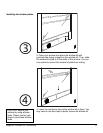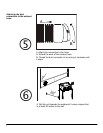
9
Your portable air conditioner is designed to exhaust condensate
water that is collected from the air. This water, in either gaseous or
droplet form, will be expelled out the exhaust port of the unit.
Please take this into account when deciding how to vent it.
1. The exhaust hose supplied with the portable air conditioner can
be extended up to 48 inches; however for maximum efficiency, use
the shortest length possible.
2. Try to prevent any kinks or bends in the exhaust hose. Kinks or
bends may trap exhaust air which can radiate heat into the room or
potentially cause the portable air conditioner to overheat and shut
itself off.
3. The exhaust hose supplied with the portable air conditioner has
been specifically designed for this air conditioner. Do not lengthen
the hose by adding additional hoses or attachments or replace it
with any other hose.
Do not lengthen the
exhaust hose by adding
additional hoses or
attachments.
Warning: Longer hoses are not recommended.
Draining the Unit
When the portable air conditioner is in cooling mode, dehumidify
mode, or heating mode, it will remove moisture from the air. The
condensed water from the air will be collected in an internal
reservoir and will be evaporated and exhausted out of the exhaust
hose. However, in very humid conditions, the internal reservoir may
fill completely. This causes the air conditioner to turn off to avoid
overflowing the internal reservoir. The WATER indicator will light up
on the Control Panel.
Direct drainage
1. Remove the rubber drain plug from the drain port.
2. Connect a drain hose to the drain port.
The portable air conditioner will now drain through the drain hose.
Please note that this unit has no drain pump; all water will drain
with gravity only, i.e., only “downhill.”
Notes about the Exhaust
hose


















